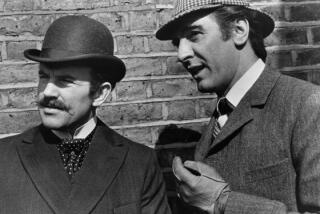Room for Creativity Is ‘Gone With the Wind’
- Share via
In September 1614, one of Spain’s most successful authors suffered a grievous affront. The bookstores of Tarragona blossomed with a spurious sequel to his most successful work--one that gratuitously insulted both the original work and its author.
So Miguel Cervantes reached for his quill and completed Part II of “Don Quixote.” In Chapter 59, he heaped gentle scorn on the spurious Part II and on its author. Today, readers around the world cherish both parts of Cervantes’ complex fable; only a few scholars even know the name of Alonso Fernandez de Avellaneda, the Aragonese hack generally credited with producing the offending sequel. But world literature is richer for their competition, which spurred Cervantes to complete and enrich his masterwork.
Fortunately for all of us, Cervantes was a genius and not the trust department of a bank. And even more fortunately, 17th-century Spain--land of the Inquisition--was in one respect freer than today’s United States. It didn’t have contemporary copyright law, which exalts the rights of the corporate owners of existing works above the impulse of authors to create, and the need of the public to read and hear, new interpretations of age-old stories.
A federal judge recently granted an injunction to block publication of “The Wind Done Gone,” an unauthorized retelling of “Gone With the Wind” from the point of view of Scarlett O’Hara’s “mulatto” half-sister. The book’s heroine, Cynara, is the invention of the author, Alice Randall. In Margaret Mitchell’s fairy-land South, there was little cruelty and no interracial sex.
In revealing language, U.S. District Judge Charles A. Pannell Jr. ruled that Suntrust Bank, which manages Mitchell’s estate, has the exclusive right to exploit her “beloved characters and their romantic, but tragic, world.” In his 51-page opinion, the entire discussion of the 1st Amendment consists of this sentence: “With respect to copyright protection, however, the 1st Amendment does not license an infringing author to trample on legally recognized rights.”
Most Americans do not realize how far we have come toward a regime in which history, myth and contested social visions can be appropriated as entertainment and then protected as property. The resulting chill on creativity leaves all of us poorer.
During its lucrative life span, “Gone With the Wind” has also become a political institution. As a white Southerner who grew up under Jim Crow, I vividly remember how many of the white people I knew believed the book, as if it were a third testament of the Bible, and cited its portrait of the plantation Tara as if it were an authoritative history of the Civil War and Reconstruction.
Of course, the facts about the period--the systematized brutality of slavery, the violent racism of white resistance to Reconstruction, the callousness of segregation--were always available in the library. But societies define themselves by myths, not facts, and the Tara myth has proved more durable than generations of scholarship and historical study.
Pannell admitted that “The Wind Done Gone” transformed the Tara myth by portraying plantation life and Reconstruction through Cynara’s eyes. But that was almost irrelevant, he held, compared with possible financial damage to the bank. That’s because some readers might accept “The Wind Done Gone” as a sequel and decide they liked that version better than “Scarlett,” the 1991 authorized sequel by Alexandra Ripley, or the second official sequel that is in the works.
So even though the publisher intended to label the book as an unauthorized parody, the marketing rights of a commercial entity take precedence over the rights of an author to criticize the myths we live by--and the rights of readers to decide for themselves which story best explains the world around us.
The court’s decision is based in part on the judge’s conclusion that much of “The Wind Done Gone” “merely summarizes most of the earlier work without any commentary or fresh ideas that challenge the reader’s understanding of the earlier work.” The bank’s attorneys produced literary experts to support that view. Of course, Houghton Mifflin, publisher of Randall’s book, had its own slew of experts to defend the new work. Pannell may be on target in his critique. But there must be something disturbing to any writer in realizing that prior restraints on publication now depend on the literary taste of federal judges.
In Cervantes’ time, literary visions fought it out on the page, with posterity as judge. The real Don Quixote, who lost so many battles, vanquished the impostor fair and square. Mitchell cannot say the same. For now, the windmills are winning.
More to Read
Sign up for our Book Club newsletter
Get the latest news, events and more from the Los Angeles Times Book Club, and help us get L.A. reading and talking.
You may occasionally receive promotional content from the Los Angeles Times.







